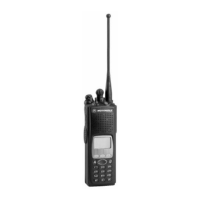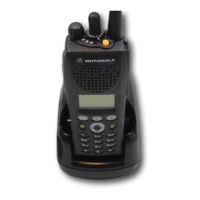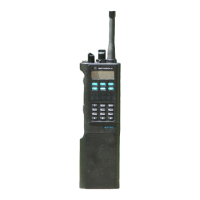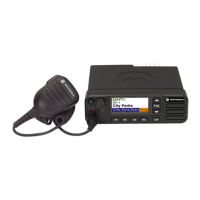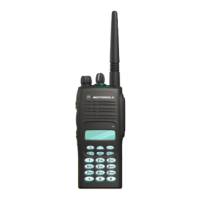Do you have a question about the Motorola II and is the answer not in the manual?
Overview of the radio's capabilities and technology.
Explanation of the technology allowing software upgrades and feature enhancements.
Instructions for checking radio contents and reporting transit damage.
Information on identifying and matching antennas to radio frequency bands.
Step-by-step guide for attaching and detaching the battery to the radio.
Procedure for safely removing the seal from the radio's universal connector.
Steps for attaching and detaching the belt clip assembly to the radio.
Detailed identification and function of radio's physical interface elements.
Explanation of the function and layout of the radio's keypad.
Description of the radio's LCD display and its status annunciators.
Explains the various audible tones the radio emits for different conditions.
Describes the meaning of different LED light patterns and colors.
Information on the feature that limits transmission duration.
Differentiates between conventional and trunked radio operational modes.
Steps for turning the radio on, off, and its power-up self-check procedure.
How to listen for activity in conventional modes without transmitting.
Guide to navigating and selecting radio zones and operating modes.
Instructions on how to receive calls in conventional and trunked modes.
Procedures for transmitting voice communications in conventional and trunked modes.
Explains the alert tone indicating low battery status.
How PL/DPL codes filter incoming messages for intended recipients.
Details on installing and loading encryption keys for secure communications.
Information on adjusting radio power levels based on frequency bands.
How to use the emergency button to send alarms or calls.
How the radio operates during trunked system failures.
How to inhibit transmission in hazardous environments.
Options for selecting the display language of the radio.
How to enable or disable audible tones for keypad presses.
How to activate or deactivate scanning using a physical switch.
Steps to enable or disable scanning mode using the radio's keypad.
How to temporarily remove unwanted modes from the scan list.
Temporarily assigning priority levels to scan list modes.
How to view the members of a programmed scan list.
Guide to changing stored telephone numbers using the radio keypad.
How to modify radio ID numbers for call lists used in trunked features.
How to redial the last number using the telephone feature.
Steps for initiating a delayed access telephone call via keypad.
Steps for initiating an immediate access telephone call via keypad.
How to call numbers stored in the radio's telephone list.
How to receive and answer incoming telephone calls on the radio.
How to redial the last number via the trunked telephone feature.
How to display the radio's unique identification number.
How to conduct private conversations with other radios.
How to use the radio as a pager to send and receive pages.
How to check the current site and manually initiate a site search.
How to manually lock the radio to a specific site, overriding automatic switching.
How radio mode selection interacts with dynamic regrouping.
How the radio displays the ID or alias of incoming callers.
How to program the HOME key for quick access to specific modes.
How signal strength and preferences determine site switching.
Setting site preferences such as always, most, or least preferred.
Requesting access when modes are busy, bypassing normal wait times.
How radios operate when a site is in trunking mode due to controller issues.
How RSSI values are displayed to indicate signal strength for site switching.
General information about batteries and their charging procedures.
A list of available accessories for the radio.
Factors affecting the radio's communication range and signal clarity.
Instructions for cleaning and handling the radio to maintain its condition.
Safety guidelines related to RF exposure and radio operation.
Information on intrinsically safe ratings for hazardous environments.
Basic troubleshooting steps and information on obtaining repair services.
Details about the optional extended service coverage plan.
Legal notices regarding copyrighted software and patents.
Overview of the radio's capabilities and technology.
Explanation of the technology allowing software upgrades and feature enhancements.
Instructions for checking radio contents and reporting transit damage.
Information on identifying and matching antennas to radio frequency bands.
Step-by-step guide for attaching and detaching the battery to the radio.
Procedure for safely removing the seal from the radio's universal connector.
Steps for attaching and detaching the belt clip assembly to the radio.
Detailed identification and function of radio's physical interface elements.
Explanation of the function and layout of the radio's keypad.
Description of the radio's LCD display and its status annunciators.
Explains the various audible tones the radio emits for different conditions.
Describes the meaning of different LED light patterns and colors.
Information on the feature that limits transmission duration.
Differentiates between conventional and trunked radio operational modes.
Steps for turning the radio on, off, and its power-up self-check procedure.
How to listen for activity in conventional modes without transmitting.
Guide to navigating and selecting radio zones and operating modes.
Instructions on how to receive calls in conventional and trunked modes.
Procedures for transmitting voice communications in conventional and trunked modes.
Explains the alert tone indicating low battery status.
How PL/DPL codes filter incoming messages for intended recipients.
Details on installing and loading encryption keys for secure communications.
Information on adjusting radio power levels based on frequency bands.
How to use the emergency button to send alarms or calls.
How the radio operates during trunked system failures.
How to inhibit transmission in hazardous environments.
Options for selecting the display language of the radio.
How to enable or disable audible tones for keypad presses.
How to activate or deactivate scanning using a physical switch.
Steps to enable or disable scanning mode using the radio's keypad.
How to temporarily remove unwanted modes from the scan list.
Temporarily assigning priority levels to scan list modes.
How to view the members of a programmed scan list.
Guide to changing stored telephone numbers using the radio keypad.
How to modify radio ID numbers for call lists used in trunked features.
How to redial the last number using the telephone feature.
Steps for initiating a delayed access telephone call via keypad.
Steps for initiating an immediate access telephone call via keypad.
How to call numbers stored in the radio's telephone list.
How to receive and answer incoming telephone calls on the radio.
How to redial the last number via the trunked telephone feature.
How to display the radio's unique identification number.
How to conduct private conversations with other radios.
How to use the radio as a pager to send and receive pages.
How to check the current site and manually initiate a site search.
How to manually lock the radio to a specific site, overriding automatic switching.
How radio mode selection interacts with dynamic regrouping.
How the radio displays the ID or alias of incoming callers.
How to program the HOME key for quick access to specific modes.
How signal strength and preferences determine site switching.
Setting site preferences such as always, most, or least preferred.
Requesting access when modes are busy, bypassing normal wait times.
How radios operate when a site is in trunking mode due to controller issues.
How RSSI values are displayed to indicate signal strength for site switching.
General information about batteries and their charging procedures.
A list of available accessories for the radio.
Factors affecting the radio's communication range and signal clarity.
Instructions for cleaning and handling the radio to maintain its condition.
Safety guidelines related to RF exposure and radio operation.
Information on intrinsically safe ratings for hazardous environments.
Basic troubleshooting steps and information on obtaining repair services.
Details about the optional extended service coverage plan.
Legal notices regarding copyrighted software and patents.
| Brand | Motorola |
|---|---|
| Model | II |
| Category | Portable Radio |
| Language | English |
